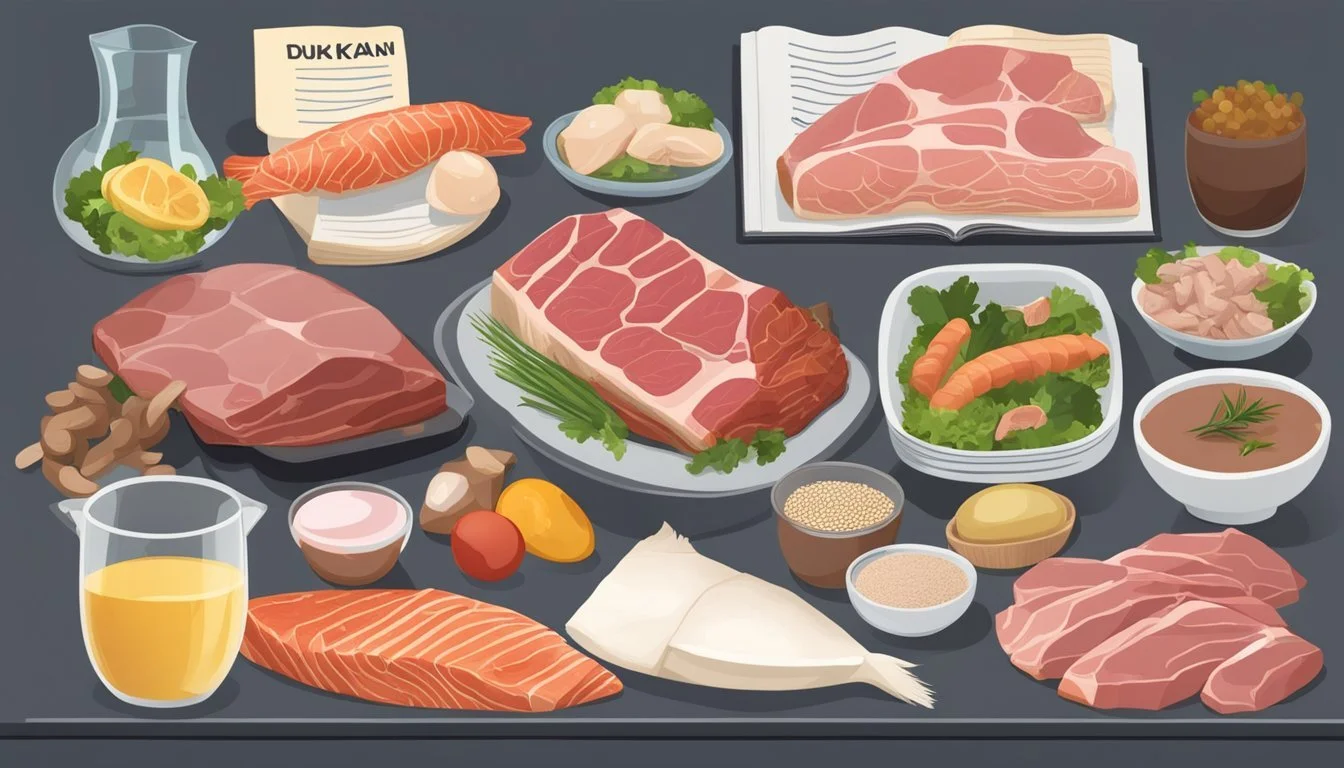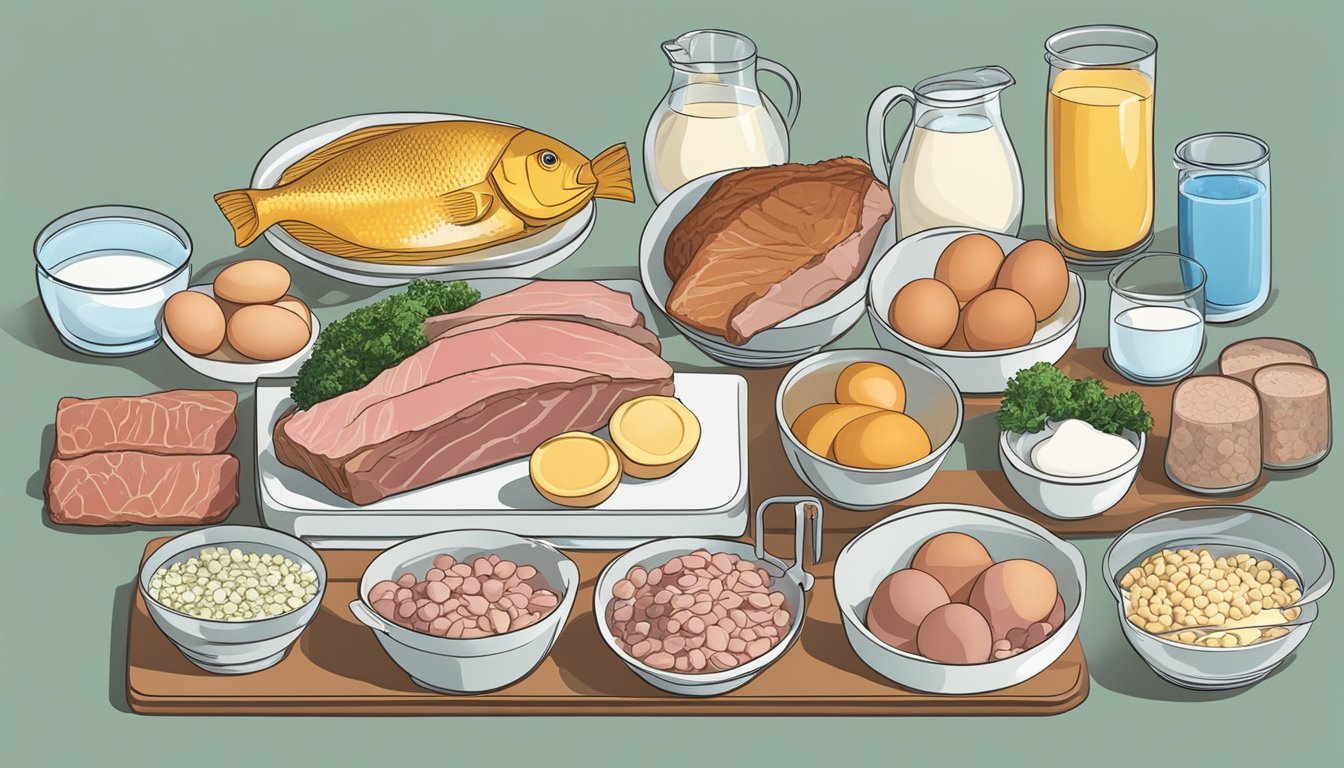Carnivore Diet vs. The Dukan Diet
Protein-Forward Weight Loss Strategies Compared
The Carnivore Diet and the Dukan Diet are two dietary regimens that prioritize protein consumption as a means to facilitate weight loss. While both highlight the importance of protein in their frameworks, they diverge significantly in methodology and overall nutritional philosophy. The Carnivore Diet is an all-animal-products approach that suggests a diet consisting exclusively of meats and animal products can lead to weight loss. It eliminates carbohydrates altogether and relies on meat, fish, eggs, and certain dairy products to provide nourishment.
On the other side, the Dukan Diet, crafted by French physician Pierre Dukan, also advocates for high protein intake but is structured in phases, starting with a strict all-protein approach and gradually incorporating vegetables and other food groups. This diet categorizes foods into 'allowed' and 'forbidden' lists, making it slightly more varied in comparison to the Carnivore Diet. The Dukan Diet aims to encourage steady weight loss without sacrificing muscle mass by focusing on lean proteins and low-fat options.
Both diets propose that by increasing protein, the body will use more energy for digestion, feel satiated for longer periods, and turn to its fat stores for energy, possibly leading to weight loss. However, these diets are often subject to criticism by nutrition experts due to their restrictive nature and potential long-term health implications. As interest in protein-forward weight loss strategies continues to grow, it is crucial to evaluate these diets on their effectiveness, sustainability, and impact on overall health.
Diet Fundamentals
The Carnivore Diet and the Dukan Diet prioritize high protein intake as a means for weight loss. They differ in their approach to other macronutrients, promoting distinct impacts on body composition and overall health.
What Is the Carnivore Diet?
The Carnivore Diet is an all-meat diet that includes primarily animal products like meat, fish, and eggs. It eliminates other food groups, advocating for a diet abundant in protein and healthy fats but devoid of carbohydrates.
What Is the Dukan Diet?
The Dukan Diet, created by French general practitioner Dr. Pierre Dukan, is a high-protein, low-carbohydrate diet that unfolds in four phases. It highlights the consumption of lean meats, oatmeal, and a strict limit on fats and sugars.
Key Principles of Protein-Forward Diets
Protein-forward diets focus on increasing protein intake to enhance satiety, maintain muscle mass, and boost the thermic effect of food. This increase can accelerate the metabolic rate, which aids in weight management.
Comparing Macronutrient Profiles
Carnivore Diet: High in proteins and fats, negligible carbohydrates.
Dukan Diet: High in proteins, moderate in select vegetables, low in fats and carbohydrates.
Understanding Weight Loss and Protein
Protein can lead to weight loss due to its ability to create a sense of fullness and because it burns more calories during digestion. Both diets leverage these features of protein but differ in their long-term sustainability and nutritional balance.
Health Benefits and Concerns
Health benefits may include improved body composition and weight loss. However, concerns such as potential deficits in essential nutrients, heightened risks for heart disease, kidney disease, and cancer should be considered in line with the Dietary Guidelines for Americans.
Each diet carries unique implications for fitness and health. It is crucial to consult healthcare professionals before starting any high-protein diet, ensuring it aligns with individual health needs and goals.
Diet Implementation and Foods
When adopting either the Carnivore Diet or the Dukan Diet, individuals are committing to high-protein, low-carbohydrate eating plans. Each diet has specific food recommendations and restrictions that are essential to understand for proper implementation.
Foods to Eat on the Carnivore Diet
The Carnivore Diet focuses exclusively on animal products, emphasizing the consumption of meat, including red meat, poultry, and fish. Followers of this diet consume a variety of animal proteins and fats, such as:
Beef, pork, lamb, and game
Organ meats like liver and kidney
Eggs
High-fat dairy products (for some variations of the diet)
This diet excludes all plant-based foods, meaning no fruits, vegetables, grains, nuts, or seeds.
Foods to Eat on the Dukan Diet
The Dukan Diet is also protein-centric but includes four phases with a gradual introduction of food groups. It prioritizes lean protein sources and includes:
Chicken, turkey, and fish
Fat-free dairy products
Tofu and other plant-based proteins (particularly in later phases)
As individuals progress through the diet's phases, they can incorporate limited portions of carbs, fiber-rich vegetables, and eventually small amounts of fruit and whole grains.
Comparison of Dietary Restrictions
The Carnivore Diet is more restrictive, eliminating all foods not sourced from animals. It is a zero-carb plan that does not allow consumption of plant-derived nutrients or fiber. Conversely, the Dukan Diet begins with strict protein intake but gradually reintroduces a broader variety of foods, including carbs and fiber from non-animal sources.
Addressing Nutrient Balance and Deficiencies
A critical concern for both diets is ensuring adequacy of all essential nutrients, vitamins, and minerals. The Carnivore Diet's lack of plant-based foods can lead to deficiencies in certain vitamins and fiber, whereas the Dukan Diet's phased approach aims to reduce this risk by allowing for a more varied intake of foods, including vegetables and grains. Both diets require careful planning to ensure intake of all essential amino acids and nutrients across all food groups to maintain long-term health.
Weight Loss Mechanics
The Carnivore Diet and the Dukan Diet place a heavy emphasis on protein's role in weight loss. These diets aim to harness protein's ability to manage appetite and boost energy expenditure, while also considering the inherent risks associated with rapid weight loss strategies.
Role of Protein in Satiety and Appetite Control
Protein consumption can lead to increased satiety and decreased appetite, as it helps individuals feel fuller for longer periods. This is due in part to the complex digestive process proteins undergo, which in turn may reduce overall calorie intake.
Impact on Muscle Mass and Body Composition
Diets high in protein assist in preserving muscle mass during weight loss, which is vital for maintaining metabolic rate. By prioritizing proteins, the body is encouraged to use fat for energy, potentially leading to improvements in body composition.
Metabolic Advantages of High-Protein Diets
High-protein diets can enhance metabolic rate due to the thermic effect of food, which is the energy expenditure of digesting and processing protein. This effect may increase caloric burn, aiding in more efficient weight loss. Furthermore, protein-rich diets like the Carnivore Diet may induce ketosis, where the body burns fat for fuel in the absence of carbohydrates.
Risks of Rapid Weight Loss
Rapid weight loss, which can occur on high-protein diets, presents risks such as potential kidney burden, liver stress, and nutrient deficiencies. It is vital for individuals to monitor their health to ensure that tissues are not damaged and overall fitness is not compromised.
By understanding these mechanics, individuals can make informed decisions on using the Carnivore or Dukan Diet for weight loss, taking advantage of the benefits while mitigating the risks.
Lifestyle Considerations
When comparing the Carnivore Diet and the Dukan Diet, a person must weigh the impact on sustainability, psychological welfare, social dynamics, and exercise routines. They should also consider how well these diets integrate into their current lifestyle.
Sustainability and Long-Term Health
The Carnivore Diet and Dukan Diet both emphasize high protein intake, but they differ significantly in their approach to healthy fats and long-term sustainability. Health experts, including registered dietitians, often stress the importance of balanced diets that align with the Dietary Guidelines for Americans. These guidelines recommend a variety of nutrient-dense foods, including vegetables, fruits, and whole grains, which are excluded from the Carnivore Diet. On the other hand, the Dukan Diet, while initially restrictive, introduces more variety in later phases, which could contribute to longer-term adherence and nutrient diversity.
Carnivore Diet: High in protein and saturated fat; lacks fiber and certain vitamins.
Dukan Diet: High in protein; phased approach with more variety over time.
Psychological and Social Aspects of Dieting
Dieting can have profound psychological effects and influence social behaviors. Diets that severely limit options, such as the Carnivore and Dukan diets, may lead to a feeling of deprivation or challenge social eating norms. When it comes to diet adherence, the simplicity of the Carnivore Diet may ease meal planning but can also make social gatherings awkward. The Dukan Diet can be more socially accommodating in its later phases.
Carnivore Diet: May affect social eating and satiety; risk of boredom.
Dukan Diet: Greater flexibility eventually aids social integration; structured plan may improve adherence.
Physical Activity and Protein Needs
Both diets provide ample protein, which is crucial for muscle synthesis and repair, especially for individuals with an active fitness lifestyle. Protein is also known for providing a high level of satiety, which can aid in reducing overall daily calorie intake. However, active individuals need to ensure they're getting enough energy to fuel their activities.
Carnivore Diet: May support high protein needs for active individuals but lacks other nutrients important for recovery.
Dukan Diet: Protein supports exercise routines; later phases better support a varied fitness regimen.
Adapting the Diets to Various Lifestyles
Adaptation of either the Carnivore or Dukan diets to specific lifestyles such as keto, vegan, or vegetarian is challenging, as both diets' foundations are built on animal-based proteins. Alternative diets like the Atkins Diet might be considered for those looking for a lower-carb lifestyle that accommodates more dietary preferences.
Carnivore Diet: Aligns well with keto but not compatible with vegan or vegetarian lifestyles.
Dukan Diet: More adaptable than the Carnivore Diet but still difficult for those avoiding animal proteins.
Conclusion and Recommendations
This section dissects the core components of the Carnivore Diet and The Dukan Diet, offering insights on diet selection and the impact on health and weight loss.
Summarized Comparison and Verdict
The Carnivore Diet, emphasizing an all-meat regimen, contrasts The Dukan Diet's structured protein-centric four-phase approach. While The Carnivore Diet might offer simpler food choices due to its exclusion of all but animal products, The Dukan Diet provides a methodical plan progressing from a high-protein start to incorporating vegetables, then a mix of proteins and vegetables, and finally a stabilizing phase. Research indicates that high-protein diets can be effective for weight loss; however, they must be balanced with other nutrients.
Expert Advice on Choosing a Diet
Registered dietitians generally advise aligning diet choices with the Dietary Guidelines for Americans, ensuring a balance of nutrients. They often recommend moderation and variety, incorporating ample vegetables, fruits, whole grains, lean proteins, and healthy fats. When considering either diet, it is essential to assess how they align with one's health goals, dietary preferences, and the ability to sustain nutrient intake over time. It is also crucial to note that overly restrictive diets may lead to nutritional deficiencies.
Future Considerations
Emerging diet trends will continue to be scrutinized through research to establish long-term health outcomes. As new studies emerge, the understanding of how high protein intake from the Carnivore Diet or The Dukan Diet influences health and fitness will evolve. Future considerations include how these diets affect chronic disease risk, mental health, and overall well-being. It's imperative for individuals to stay informed through reputable health sources and consult healthcare professionals before embarking on significant dietary changes.
Appendices
This section offers detailed insights including nutritional values, diet-specific meal plans, and resources for further education on the Carnivore and Dukan Diets, focusing on high-protein intakes central to both approaches.
Appendix A: Nutritional Breakdown of Common Foods
Nuts: High in fat and protein, a serving of almonds (28g) contains 6g of protein.
Cheese: Varied in type, Cheddar cheese offers about 7g of protein per 1-ounce slice.
Greek Yogurt: A 200g serving typically contains 17g of protein and is a staple in the Dukan diet.
Beans: Not included in the Carnivore Diet; a cup of cooked black beans contributes roughly 15g of protein.
Chicken Breast (What wine goes well with chicken breast?): Lean protein source, containing approximately 31g of protein per 100g serving.
Appendix B: Sample Meal Plans for Both Diets
Carnivore Diet Sample Day:
Breakfast: Scrambled eggs with bacon.
Lunch: Grilled chicken breast with melted cheddar cheese.
Dinner: Pork chops (What wine goes well with pork chops?) cooked in butter.
Dukan Diet Sample Day:
Breakfast: Greek yogurt with 2 tablespoons of oat bran.
Lunch: Salad with grilled chicken breast and 0% fat dressing.
Snack: A slice of low-fat cheese.
Dinner: Baked fish with a side of steamed vegetables.
Appendix C: Resources for Further Reading
For evidence-based information:
Dietary Guidelines for Americans: Recommendations for nutrition and health.
Health Publications: Articles on nutrition science and diet reviews.
Readers may consult a registered dietitian for personalized nutritional advice.
References
When considering the Carnivore Diet and the Dukan Diet, one must draw information from diverse, reliable sources. Below is a curated list of references that shed light on these high-protein weight loss regimens:
Healthline: Offers an insightful review of the Dukan Diet focusing on its phases and potential effects on weight loss.
Forbes Health: Discusses the popularity and fundamental principles of the Dukan Diet, emphasizing protein's role in the weight loss process.
EatingWell: Provides a dietitian's perspective on the Dukan Diet with details on its creation and its low-carbohydrate, high-protein approach.
Scientific Studies: Outlines the nutritional impact and cardiovascular risk factors associated with the Dukan Diet based on long-term research results.
Primary Components
Carnivore Diet: Predominantly meat-based, eliminates carbohydrates, and emphasizes fat and protein consumption.
Dukan Diet: Structured in four phases, promotes a high-protein, low-carbohydrate intake, with a gradual reintroduction of certain foods.
Published Material
Books by diet creators
Peer-reviewed articles evaluating diet efficacy
Additional Sources
Health practitioners may contribute personal insights based on clinical experience with patients on these diets, further informing on practical outcomes and sustainability.






